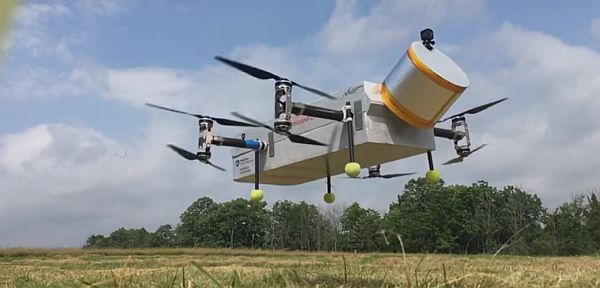Podcast: Play in new window | Download (Duration: 31:46 — 21.9MB)
EHang is flying its urban air mobility vehicle contender. Remote identification of drones is moving forward. Also, using drones to measure methane emissions, find standing water where mosquitoes breed, assess hurricane damage, explore Titan, and plant trees.
UAV News
EHang completes first passenger-carrying autonomous aerial vehicle demonstration flight
The EHang 216 passenger-carrying autonomous aerial vehicle (or AAV) was flown at the 2019 Northeast Asia Expo in August. Ehang has been demonstrating the aircraft at several cities in China as well as in Austria, the Netherlands, and Qatar. Ehang says, “This is a critical step towards making our dream [a] reality and to make urban air mobility broadly available and affordable as a safe, fast, and eco-friendly transportation alternative.”
Video: EHang AAV Trial Flights Across Cities in China
Electronic License Plates for Drones May Come Soon
A draft of the proposed ASTM standard for electronic identification of drones is available as ASTM WK65041, “New Specification for UAS Remote ID and Tracking.” During operation, a drone would transmit a unique ID, location, and vector. The chairman of ASTM International’s Committee F38 on Unmanned Aircraft Systems said, “You can just take a phone, point it up at a drone and get its electronic ID if you see it doing something dangerous. [And you can report it] just like reporting a car’s license plate number.” Old drones can be retrofitted with ID chips that would plug into their USB ports and might cost $7 to $12.
BP deploys continuous methane measurement for new major oil and gas projects
BP said it is going to monitor its methane emissions around the world using a technology called gas cloud imaging and drones. Inspections would take 30 minutes instead of seven days. The sensor technology was originally designed by NASA for the Mars Curiosity Rover. This is a key part of BP’s strategy to deploy a suite of complementary methane detecting techniques across new and existing facilities.
Anthropology professor deploys drone to fight disease in Africa
Mosquitoes are the main transmitters of malaria, and they breed in standing water. Agricultural irrigation can create standing water which is difficult to detect with satellite imagery. In the East African nation of Malawi, Professor Jon Carroll and other researchers from Oakland University spent nine days collecting data on the effectiveness of drone imagery to detect standing water.
AIRT uses UAS to perform damage assessment operations in the Bahamas following Hurricane Dorian
Two organizations have formed a joint-reconnaissance team to survey the Bahamas following Hurricane Dorian: the Airborne International Response Team (AIRT) and the Southeast Florida Region 7 All-Hazards Incident Management Team (SEFL-R7 AHIMT). Disaster scenes were mapped by UAS with high-resolution camera systems.
Meet The Nuclear-Powered Self-Driving Drone NASA Is Sending To A Moon Of Saturn
The Dragonfly is a dual-rotor quadcopter, about the size of a compact car, autonomous, and nuclear powered. Expected to launch from Earth in 2026 and arrive on Titan in 2034, Dragonfly will explore Titan’s dunes, mountains, gullies, and rivers and lakes of liquid methane.
NASA Video: New Dragonfly Mission Flying Landing Sequence Animation.
Middle East drones signal end to era of fast jet air supremacy
Air superiority has been key to winning wars since airplanes were invented. But compared to the world’s major air forces, drones are small, low cost, and they don’t put a pilot into the war-zone.
This startup lets you subscribe to support an army of drones that’s planting millions of trees
A new startup called Now wants to “mobilize humanity to reverse the climate crisis.” The organization was created by 19-year-old activist and musical artist Xiuhtezcatl Martinez who says that if a trillion trees are planted, they could capture two-thirds of the carbon that humans have emitted since the industrial revolution. The subscription concept of Now would fund planting trees with drones. See also 19-Year-Old Xiuhtezcatl Martinez Isn’t Waiting For Permission to Solve the Climate Crisis: “The Time Is NOW.”
Conference
Commercial UAV Expo Americas 2019, October 28-30, 2019 in Las Vegas. Video: Commercial UAV Expo 2018 in a minute.

